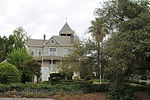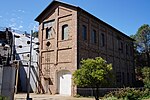Candy Store Gallery
1962 establishments in California1992 disestablishments in CaliforniaArt museums and galleries established in 1962California building and structure stubsContemporary art galleries in the United States ... and 4 more
Defunct art museums and galleries in CaliforniaFolsom, CaliforniaOrganizations disestablished in 1992United States art museum and gallery stubs
The Candy Store Gallery (from 1962 to 1992) introduced many important artists and styles of art, and was a leading showcase for the Funk artists of Northern California, United States.
Excerpt from the Wikipedia article Candy Store Gallery (License: CC BY-SA 3.0, Authors).Candy Store Gallery
Sutter Street, Folsom
Geographical coordinates (GPS) Address Nearby Places Show on map
Geographical coordinates (GPS)
| Latitude | Longitude |
|---|---|
| N 38.6782 ° | E -121.1755 ° |
Address
Sutter Street 604
95630 Folsom
California, United States
Open on Google Maps








